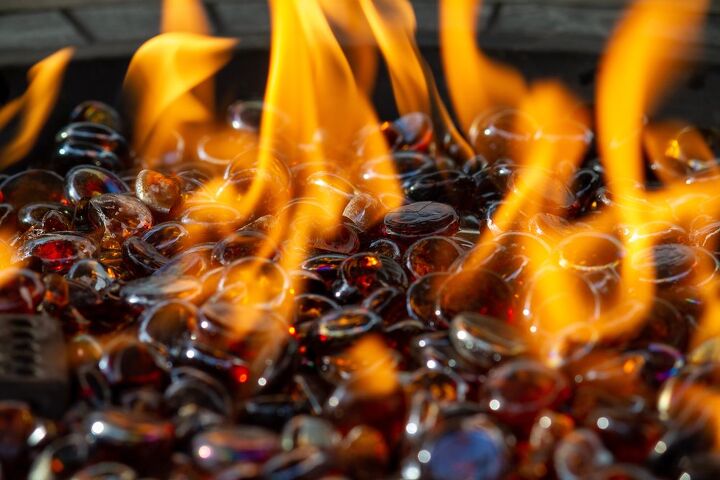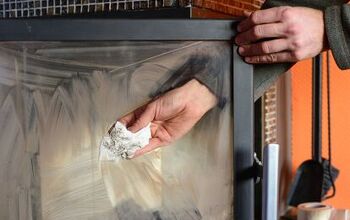How Does Fire Glass Work?

If you’re asking yourself about what fire glass is and how it works, you’re not alone. Fire glass is relatively new to the fireplace scene, but it’s certainly leaving its mark and making an impact. But how on earth is glass able to be burned and not shatter, melt, or break down?
Fire glass is specially-prepared and pressure-treated to be able to withstand extremely high heat. After being pressured or chemically treated, fire glass is able to sit in the fire without breaking down or releasing dangerous fumes. It won’t burn, melt, or explode like regular glass does under excessive heat, and is also immune to discoloration.
Fire glass has taken the world by storm due to its many benefits and its beauty. Its ability to withstand and radiate high amounts of heat makes it the envy of fire pits everywhere. Combine that with the dazzling colors it emits and you’ve got yourself a recipe for greatness. Keep reading to learn more about fire glass and how it works.
Do You Need Brick or Stone Fireplace Installation?
Get free, zero-commitment quotes from pro contractors near you.

How Does Fire Glass Work?
Fire glass consists of small pieces of shattered tempered glass that’s been specially treated. The two options for treating fire glass are with chemicals or by pressure-treating it. Either way, the result is pieces of glass capable of withstanding extremely high temperatures without breaking down or emitting toxic fumes.
The pieces of glass are then placed directly over the open flame of a propane or gas fire. As the flames shine through the glass, it emits breathtaking colors and shines in a unique way. The flames seemingly leak out around the glass and make it appear as if they’re dancing. The glass then acts as a radiator of sorts and radiates massive amounts of heat, making your fire even hotter than it would otherwise be.
Explainer Video: What is Fire Glass?
What Exactly is Fire Glass?
As previously mentioned, fire glass is pieces of shattered, tempered glass that’s pressure or chemically treated. The pieces of broken glass are then polished and tumbled to make it gleam and glimmer. Tempered glass is also known as safety glass and is used for many aesthetic purposes. It’s also thicker and tougher than other types of glass, which makes it impermeable to shattering.
Fire glass is available in whatever color you desire and its primary purpose is to be aesthetic. Colors such as sky blue and pearly white are very popular because it gives off a fire and ice effect. As an extra safety measure, fire glass is tumbled so that there aren’t any sharp edges on the pieces of glass.
Another cool feature about fire glass is that it’s usually made out of recycled glass. Whether it’s recycled or not, however, only tempered, safety glass can be used as fire glass. Trying to use regular glass will result in nasty fumes and also presents the risk of exploding. The last thing you want while sitting around a fireplace is for thousands of tiny shards of glass to come flying your way.
How do You Use Fire Glass?
If we’ve piqued your interest and you want to give fire glass a shot, then this is the section for you. To use your fire glass, you’ll want to place them in a special burner that’s specifically designed for fire glass. Using the correct burner will produce the most beautiful aesthetics and will prolong the life of your fire glass.
If you want to opt not to use a burner to put your glass in, you can optionally put the fire glass directly into the fire pit or fireplace. Doing this requires the right kind of pit, however, because the pieces of glass might be too small and fall through the pit. For this reason, using a burner pan is the best way to use fire glass.
At any rate, there’s no special science to using fire glass. You can use it with any type of fireplace that uses gas or propane as its fuel. Fire glass is especially dazzling when used with tabletop or bowl-shaped fire pits. Make sure that you evenly distribute the fire glass to create a flat surface for the flames to dance on.
What Goes Underneath Fire Glass?
You can pour your fire glass directly into the fire pit or fireplace, or you can purchase a special burner for the glass to sit in. Using a burner that sits between the fire glass and the source of the flame is the most common way to use fire glass, but it isn’t mandatory.
Can You Use Fire Glass Without Gas?
The best way to use fire glass is with clean, natural gas. Natural gas burns cleaner than other types of fuels such as propane, oil, and wood. Technically speaking, you can use fire glass with whatever you want, it just won’t look as good. Attempting to use fire glass with wood, for example, will possibly damage the glass and make it unusable.
Wood also doesn’t burn cleanly and produces a ton of smoke. Smoke will make your fire glass appear dirty and stained and reduce its aesthetic ability. Propane is better than wood, but will still burn slightly dirtier than natural gas. Propane won’t ruin your fire glass, but it will make it appear dirty, which will lead to it not lasting as long as it otherwise would.
Is Fire Glass Long Lasting?
If you properly care for your fire glass and only use it with clean forms of fuel, it can last up to 20+ years. On average, however, fire glass usually lasts anywhere from four to eight years.
Because of how fire glass is prepared and what it’s made from, there isn’t a definite lifespan for it. Tempered glass can last indefinitely and should never melt or break down. The main reason that fire glass needs to be replaced is that it gets too dirty and no longer serves any real purpose.
Advantages of Using Fire Glass
Now that we know what fire glass is and how it works, let’s look at some of the reasons that people choose fire glass for their fireplaces.
- Low Maintenance
If you’re tired of the smoke and cleanup involved with burning wood, fire glass is just the ticket. It doesn’t leave any ashes or soot to clean up and it doesn’t discolor unless you burn it with wood or propane. You also don’t have to worry about adding more wood to the fire with fire glass.
- Durable and long-lasting
As previously mentioned, fire glass can last up to 20+ years if you care for it and only burn it with clean gas.
- Aesthetically-pleasing
The main reason that people like fire glass is because of how beautiful it is. The dancing and shimmering flames combined with whatever color you chose for your glass is a truly unique and beautiful combination.
- Produces heat
Fire glass radiates heat in a way that other forms of fuel simply can’t. It’s a great addition to a gas fire to help take the edge off of chilly nights.
Related Questions
Does fire glass produce heat?
While fire glass in itself doesn’t have the ability to produce heat, it does radiate it quite well. High-quality fire glass can make your fire three or four ties hotter than it would be without fire glass.
Can I cook food over fire glass?
If you have a gas or propane fireplace that has fire glass in it, it’s perfectly safe to cook food or roast marshmallows over it. The glass has no negative taste or health effects on the food. Make sure that you’re careful not to spill food onto the glass, however, as it can be difficult to clean up.
How much fire glass do I need?
The amount of fire glass you need depends on the size of your fire pit or fireplace. In most cases, the goal is to completely fill your fire area to get the most out of your fire glass. Once you’ve calculated the diameter and depth of your fire pit, you can determine how much fire glass you need.
Do You Need Brick or Stone Fireplace Installation?
Get free, zero-commitment quotes from pro contractors near you.

Final Thoughts
Whether you want a beautiful campfire or to spice up your indoor fireplace, fire glass will get the job done. The way that it’s prepared and tested guarantees the safety of you and your home. Once you make the switch to fire glass, you’ll find it extremely difficult to have a fire with anything else.

Before I started writing, I worked for 6 plus years in the plumbing, electrical, and HVAC business. I was primarily an HVAC installer but also worked as a plumber and electrician. Now I'm a copywriter, focusing on home improvement content and guides.
More by Jalin Coblentz











![How Much Weight Can a 4×4 Support Horizontally? [It Depends!]](https://cdn-fastly.upgradedhome.com/media/2023/07/31/9070333/how-much-weight-can-a-44-support-horizontally-it-depends.jpg?size=350x220)















